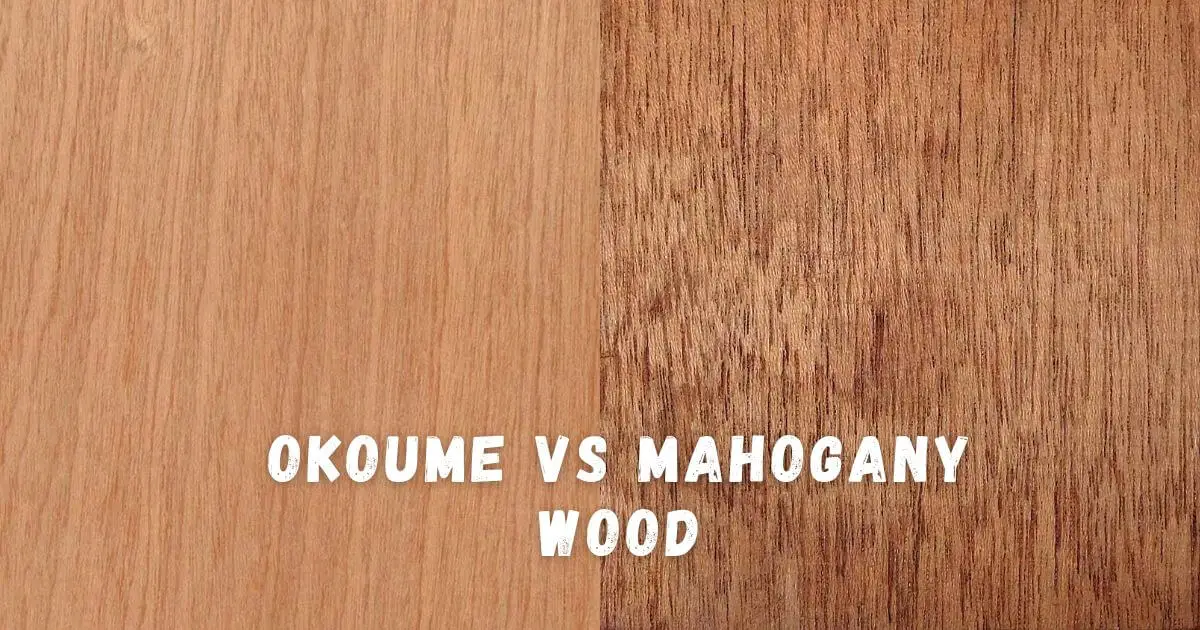The difference between Mahogany and Okoume is that Mahogany is darker, more durable, and insect resistant than Okoume wood. Both woods are hardwoods and are widely used for woodworking.
What is Okoume Wood?
Okoume wood is highly durable, stable and rot-resistant hardwood commonly used for furniture and musical instruments. Okoume wood, also known as Gaboon or Okoumé, is a type of hardwood that originates from the African Okoume tree (Aucoumea klaineana). It is native to the equatorial forests of Central Africa, primarily Gabon, Congo, and Equatorial Guinea.
What is Mahogany Wood?
Mahogany is durable, stable and straight-grained hardwood. It is popular for its workability and attractive appearance. It is widely used for making high-quality furniture and musical instruments. Mahogany is native to the tropical regions of the Americas.
Mahogany wood is considered a premium choice for high-quality and long-lasting woodworking projects.
Here are the difference between Okome and Mahogany Wood
| # | Okome Wood | Mahogany wood |
| Scientific name | Aucoumea klainiana | Sweetenia macrophylla, |
| Tree Height | 100-110 ft (30-38 m) tall,3-6 ft (1-1.8 m) trunk diameter | 75 -200 ft (23 -60 m) tall, 3-6 ft (1-2 m) trunk diameter |
| Crushing Strength | 5,250 lbf/in2 (36.2 MPa) | 6,760 lbf/in (46.6 MPa) |
| Janka Hardwood | 400 lbf (1,790 N) | 900 lbf (4,020 N) |
| Insect Resistant | Poor insect resistant | Very resistant |
| Wood Type | Hardwood | Hardwood |
Uses
Both Okoume and Mahogany wood are commonly used for veneer, cabinetry, plywood, furniture, boatbuilding, musical instruments, and carving.
Since we mentioned above that okoume wood does not have insect resistant properties, it is not as popular as mahogany for outdoor furniture. But okoume has good water resistance so it can be used for boatbuilding with sealer finishing.
Wood Tone
Okoume Wood produces a softer tone than mahogany wood, while Mahogany produces a hard, dense and good high-end response.
Appearance
Okoume Wood ranges from a pale pink to light brown, sometimes with a golden hue. It has a straight grain pattern and a fine texture. Wood grain can be straight or wavy or interlocked. The texture is low to medium.
Mahogany wood ranges from light pinkish brown to deep reddish brown. It has straight or wavy grain pattern and texture can be medium to uniform.
Like most hardwoods, Okoume and Mahogany wood darken over time. It rapidly changes its color when exposed to direct sunlight.
Rot and Insects Resistant Workability
Okoume wood is not naturally resistant to rot and insects while mahogany is highly resistant. That’s why mahogany does not require additional treatment while okoume wood requires chemical treatment and exterior finishing.
Which wood is easier to work with? Okoume or Mahogany Wood
Mahogany wood is easier to work with than okoume wood, as okoume wood contains a high amount of silica which creates a blunting effect on the tool blade.
If working with small tools, then Okoume wood can be worked more easily. Because the density of Okoume wood is less than Mahogany.
Both the woods can be easily finished and hold the stain very well. Use sharp tools while planing and shaping with these woods as they often create fuzzy surfaces.
Price
Mahogany is more expensive than Okoume wood, because Mahogany is in high demand in the market and real Mahogany only grows in Central and South America, making it rare.
But Okoume wood is not cheap at all; it is available in the market at moderate price.
Hardness
Mahogany has higher density and weight than Okoume wood. The Janka hardness value of Mahogany wood is 900 lbf (4,020 N) while that of Okoume is 400 lbf (1,790 N).
Here are the Janka hardnesses of other popular hardwoods, so you can compare how hard mahogany and okoume woods are.
| Wood species | Janka Hardness |
| Balsa | 67 lbf (300 N) |
| Quaking Aspen | 350 lbf (1,560 N) |
| Norway Spruce | 380 lbf (1,680 N) |
| Okoume wood | 400 lbf (1,790 N) |
| Lodgepole Pine | 480 lbf (2,140 N) |
| Douglas fir | 620 lbf (2,760 N) |
| Cyprus cedar | 820 lbf (3,670 N)* |
| Mahogany wood | 900 lbf (4,020 N) |
| Teak | 1,070 lbf (4,740 N) |
| oak | 1,220 lbf (5,430 N) |
| Hard maple | 1,450 lbf (6,450 N) |

